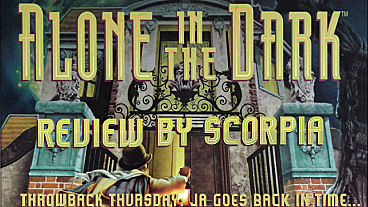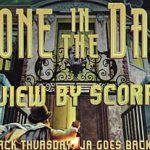
Throwback Thursday: Alone in the Dark
Overall, Alone In The Dark is one of those neat games with some irritating flaws. Lovecraftian overtones contribute a lot to the atmosphere, which is well-maintained. Graphically, the monsters could have been better.




Note: Review originally published in 1999
Drawing heavily (in some respects) on the works of H.P. Lovecraft, Alone is set in Louisiana during the 1920s. A private investigator is hired to visit an old house and retrieve a document from inside a piano stored in the attic. Naturally, there is more here than meets the eye, and before long this simple errand turns into a life-and-death struggle with the evil that infests the house.
The designers have done a good job of establishing mood, a very important aspect for games of this type. Anyone familiar with Lovecraft’s works knows that diaries, books, journals, letters, etc., usually play an important role in his stories. That is also the case here; there is much reading material to be found throughout the house. Some of it contains clues to solving puzzles, some fills in the history of the mansion, and some seems to be there just to enhance the eeriness of the whole experience. Very definitely, reading is an integral part of the game, and should not be skipped.
Sound is used to good effect. Floors creak when you walk on them, as do doors when opened, and quite realistically. Each weapon type has its own sound: the blast of a gun, the “woosh” of a sword, the twang of a bow. Your character grunts with the effort of combat, and cries out when injured. From time to time, odd moaning and wolf howls float through the air.
Music is good, but perhaps a little too fast-paced. Something a bit slower and more ominous would have fit into the atmosphere better, particularly when walking through the empty (and not so empty) rooms. As it was, the music became annoying at times, and I turned it off occasionally.
Graphically, the game has a unique feature: the use of different viewing angles throughout play. A typical adventure usually has one view, either you-are-there 3D, or some sort of you-see-the-character-on screen view. While Alone uses the see-the-character view, this is done from different perspectives in different locations.
These angles range from looking from the floor up to looking from the ceiling down. Years of watching horror movies have taught us that when the viewing perspective changes, it usually means that something is up (maybe creeping up!), thereby creating a certain amount of tension. This cinematic approach is used very effectively, keeping you alert and worried over what’s about to happen.
However, this same technique has drawbacks on occasion. There are some situations where maneuvering the character while the angles change can make your life difficult. Imagine running around narrow library corridors while being chased by a critter that can walk right through walls and the perspective changes constantly as you move.
Worse yet, in the end game, you have to wade into the middle of a lake, while Deep Ones (nasty water monsters) are coming up on the side, and a tree in the lake is tossing fireballs your way. The initial view is full-figure, but partway into the water, it suddenly changes to a close-up of the character. This is not only disorienting, but makes it extremely difficult to see which way to go to avoid being killed. The full-figure view should have been continued longer, or at the very least, a close-up of the forward view ahead of the character used. As it is, this section of the game will likely give many players unneeded frustration, and they may well have to go through this part more than once to complete it.
There is also a lot of jumping around necessary in the tunnels. In some parts, it’s very tricky making the leaps, and the angle changes can make it more so. Save often when hopping across pillars or over rotten bridges. Deep Ones are always lurking the water, waiting to rip you to shreds.
While there is fighting in Alone, it isn’t by any means a CRPG. Aside from hit points, there are no physical attributes or skills, and there are no experience points or levels of any kind. Killing monsters has only one purpose: to get them out of your way.
Combat itself is therefore simple, and more a matter of timing than anything else. Your character arms with a weapon (or uses fists/feet if no weapon is available), faces the creature, and lets loose. Facing is very important here, especially when using a revolver or rifle. It is quite easy to miss with those weapons if you’re not looking in the right direction. I much preferred the sword in most fights, as you can be a little off and still hit opponents, and you don’t need ammunition for it.
Which brings us to another little sore point in the game. Critters fall into three basic categories: those that can be killed, those that are unkillable, and those which require special methods to be removed. It is not always easy to determine which type of critter belongs in which category.
You can waste a lot of time trying to kill something that can’t be destroyed. The bathtub monster is one of those, and so is the big worm (actually a Chthonian) that lurks in the tunnels. The rats in the cellar and the spiders in the garden are also unkillable. On the other hand, the immaterial critter in the library can be killed, but you need a special weapon for that, and the strange creatures guarding the stairway down from the balcony require non-violent methods.
So the first rule is: if you can’t kill it right off, stay away from it until you’ve done more reading and/or found some other items to try out. Be careful with the cavalry saber. It has a special use in the game, and should not be wielded as a weapon, as it is prone to breaking. The saber can still be used for its special purpose if broken (and you have both parts), but it’s not a great weapon anyway, and there are plenty of better ones available.
The game also has a couple of “gotchas”. Most of the reading material is safe, but a couple of things aren’t wise to read. Unfortunately, none of the books have exterior titles, so they have to be opened before you know what you’re looking at. By then, it could be too late.
For instance, I opened one book to the title and saw “De Vermis Mysteriis”. No. We will NOT read this book. As a reader of Lovecraft, not to mention Call of Cthulhu player, I knew this one was deadly. Too late. Just looking at the title page alone is enough to kill you. Beware of books with red or yellow covers. Save before you read!
Another problem can crop up in the end game. It is absolutely vital that, after passing through the “maze”, you have at least a little oil left in your lantern, or a spare can of oil, plus the lighter. Without those, you cannot finish. Once you enter the tunnels under the house, there is no going back up again until you’re done down there. If you’ve left the spare oilcan behind, or even worse, used up all the oil, you are in big, big trouble.
While there aren’t many dark rooms in the house, you can use up a lot of oil going through the library, which is actually four rooms in all. The best thing to do here is get through it as quickly as possible. Pick up everything you come across, and wait until you’re outside (and the lamp off) before reading anything.
If you waste no time in any of the dark rooms, you should still have some oil from the first can, with the second as a spare for later. It doesn’t matter if you run out of oil going through the maze, as for some reason the lamp will stay lit until you’re out of it. So long as you have that second can in reserve, you’re okay.
It was an unwarranted assumption on the part of the designers that a player would have sufficient oil for the big moment. Some people went through almost to the end, only to find they had to replay a lot of the game, or most of the endgame, because they had no oil. Either they ran out of oil entirely, or left the spare can upstairs (there is only so much you can carry). All this could have been avoided if an extra oil can had been placed somewhere down in the tunnels.
The interface is mouse-driven, although you can also use the keyboard. It takes a little getting used to, but once you have the hang of it, is really simple and fairly efficient.
Saving and restoring can be done almost any time in the game, including in combat. While there aren’t many slots available, there is one interesting feature to it: each save is accompanied by a small picture, a “snapshot” of where the character was when the game was saved. This, along with the title (which can have only the standard MS-DOS eight characters), can be very helpful in determining which position to bring back.
Overall, Alone In The Dark is one of those neat games with some irritating flaws. It sets a good atmosphere and maintains it well for the most part. Using Lovecraftian overtones adds a lot to the game. The view shifts are a novel and effective addition. Most of the puzzles are fair. The game did NOT crash on me, or exhibit technical problems (big plus right there).
Graphically, the monsters could have been better; some of them looked more ludicrous than horrible, dangerous though they were. The viewing angles could have been planned more carefully, and the design in general should have been tighter to prevent nasty dead ends, such as running out of oil in the tunnels. Since you’ve been warned about those, however, you should find Alone In The Dark a nice change of pace from the usual run of adventure games.
Just Adventure Assigned Grade: A-
System Requirements:
IBM CD:
IBM 386SX higher and 100% compatibles (DX recommended). DOS 3.1 or higher. 640K with 575K free base RAM. VGA/MCGA graphics card (VGA 256 colors). Hard disk required with at least 8MB free. Requires MPC compliant CD-ROM drive with speakers or headphones. Sound boards supported: Sound Blaster & 100% compatibles, Covox Sound Master 2, Disney Sound Source
IBM DISK:
Does not include voice-overs or soundtrack. IBM PC AT or 100% compatible. (286/16mhz minimum, 386 recommended). VGA or MCGA graphics card (VGA 256 colors). 5MB hard disk space. 640KB RAM (560KB free). 3.5″ or 5.25″ disk drive. Sound Blaster, Sound Master 2/+, Adlib, Sound Source or DAC sound cards
Mac:
68040 microprocessor (minimum)
256-color display
3500k free memory
System 7.0 or later
Hard disk with 13 MB free disk space required
Doublespeed (or faster) CD-ROM drive
Quicktime 2.0 required

Leave a Reply